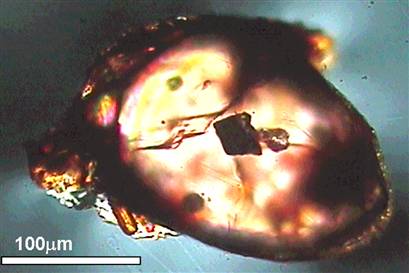
4.45 billion year old diamonds found in zircons, reports Joe McCall
Geoscientist Online 23 August 2007
The Mount Narryer/Jack Hills Archaean rocks of Western Australia, about 900km north of Perth, are renowned for the presence of zircons that yield radiometric age dates greater than 4 billion years
1.
Now M. Menneken et al. have reported that such zircons contain diamond inclusions, diamonds that are ~1 billion years younger than the oldest previously known terrestrial diamonds
2. The researchers used Raman laser technology to analyse 1000 randomly selected zircon grains ranging in age between 4.3 and 3.1 billion years. 45 grains included diamonds. The maximum age determined is 4.25 billion years.
These discoveries are important as they suggest that planet Earth formed continental crust and oceans as early as 4.4 billion years ago, contrary to conventional beliefs.. The Hadean period (greater than 4 billion years, the first 500 million years in Earth history) had been supposed to be a time of extreme volcanic activity and frequent impacts by extraterrestrial bodies. The Jack Hills zircons contain high levels of oxygen isotopes which could only come from clay, which forms in water at the Earth’s surface. The diamonds could be impact-produced, but this is extremely unlikely and other lines of evidence suggest that the zircons formed in an extremely early continental crust. The zircon crystals show no signs of high pressure.
Dr Ian Williams of Australian national University is sceptical about the ‘cool Earth’ alternative theory, suggesting that the zircons may have formed from deep magmas at high pressure. He suggests tests on the carbon isotope composition and determination whether nitrogen is present as single or paired atoms. The Jack Hills finds are unquestionably important in providing a window into an otherwise obscure period in Earth history. We can look forward to future highly-refined isotopic studies of Jack Hills material and a controversy ongoing for some years yet.
- Wilde, S.A., Valley, J.W., Peck, W.H. & Graham, C. 2001. Nature 409, 173-178
- Menneken, M.,, Nemchin, T., Geisler, T., Pidgeon, R.T. and Wilde, S.A. 2007. Oldest terrestrial diamonds in zircon from Jack Hills, Western Australia. Goldschmidt Conference Abstracts 2007, p A 652.